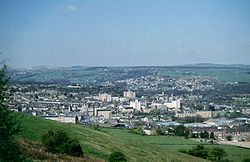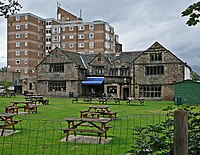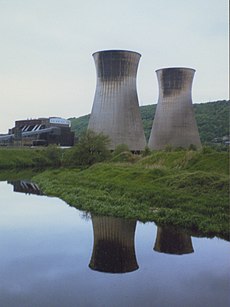Elland
| Elland | |
| Yorkshire West Riding | |
|---|---|
 A view of Elland | |
| Location | |
| Grid reference: | SE106208 |
| Location: | 53°40’59"N, 1°50’24"W |
| Data | |
| Population: | 14,554 |
| Post town: | Elland |
| Postcode: | HX5 |
| Dialling code: | 01422 |
| Local Government | |
| Council: | Calderdale |
| Parliamentary constituency: |
Calder Valley |
Elland is a market town in the West Riding of Yorkshire. It is south of Halifax, by the River Calder and the Calder and Hebble Navigation.
Elland was recorded as Elant in the Domesday Book; the town's name is derived from the Old English ea land, meaning "River land" or sometimes "Island". It had a population in 2001 Census of 14,554.
History
Mentioned in the 1086 Domesday Book as Elant, Elland was a centre of wool production. The decline of the woollen industry had a significant effect on the town and many mills were demolished or converted to residences.
Elland retained continuity of tenure from before the Norman Conquest into the Middle Ages, as the Elland family were descended from Anglo-Saxon thegns. The Manor of Elland, with Greetland and Southowram formed an island of the Honour of Pontefract in the surrounding Manor of Wakefield.
In 1350 Sir John de Eland was murdered, as was his son in the following year, which extinguished the male line of the family and the manor passed to the Savile family. From this period, the manor house ceased to be the principal dwelling of a gentry family, as the Saviles had their seat at the moated manor of Thornhill. Elland manor house was never completely reconstructed and, when dismantled and excavated in 1975 by the West Yorkshire Archaeology Unit, it was found to incorporate a 13th-century solar wing – one of the earliest secular buildings in the county. The manor house stood on a knoll aligned with the bridge over the River Calder and was destroyed during the construction of Calderdale Way bypass. The farm buildings survive.

At the request of John de Warenne, 7th Earl of Surrey, Edward II granted a charter, to John de Eland, for a free market on Tuesday at his Manor of Elland, and two fairs.
Economy
Elland was famous for durable flagstones which, after construction of the canal, could be transported economically all over the county.[1][2]
Elland housed the main factory of the manufacturer of Gannex products[3] and is the home of the Dobsons sweet factory, which produces traditional boiled sweets. Since 2001, Elland has been home to Suma Wholefoods, the largest Worker cooperative|workers' co-operative in the United Kingdom. The town was run by Elland Urban District Council which was merged into Calderdale Metropolitan Borough Council on 1 April 1974.
About the town
Buildings of interest include the parish church of St Mary's the Virgin, the former Rose and Crown Inn in Northgate, the Old Town Hall, Southgate Methodist Church, the reputedly haunted Fleece Inn at the top of Westgate,[4] the Rex Cinema, the Swimming Baths and Waxman ceramics on Elland Lane.
The remains of the mediæval stocks can be found at the junction of Southgate and Elizabeth Street.
Elland Power Station

Elland Power Station was a coal-fired power station by the River Calder. It was decommissioned and closed in 1991, in keeping with the trend of generating power at fewer but larger power stations away from towns, and demolished in 1996.
References
- ↑ "Coal Measure Sandstones (Westphalian)". English Stone Forum. http://www.englishstone.org.uk/documents/dimension%20stone%207.html. Retrieved 15 June 2010.
- ↑ "A guide to Elland". Information Britain. http://www.information-britain.co.uk/county97/townguideElland/. Retrieved 15 June 2010.
- ↑ Martin Wainwright (20 March 2002). "Historic Gannex factory may make for a supermarket". The Guardian. http://www.guardian.co.uk/uk/2002/mar/20/martinwainwright. Retrieved 15 June 2010.
- ↑ "History of The Fleece Inn". Greater Elland Historical Society. http://www.gehs.org.uk/Local%20Stories/fleece_inn.htm. Retrieved 15 June 2010.